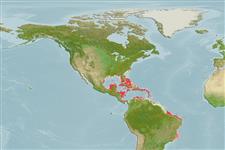>
Holocentriformes (Squirrelfishes, soldierfishes) >
Holocentridae (Squirrelfishes, soldierfishes) > Myripristinae
Etymology: Plectrypops: Greek,plektron = anything to strike with, spur + Greek, ops = appearance (Ref. 45335).
More on author: Guichenot.
Environment: milieu / climate zone / depth range / distribution range
Écologie
marin récifal; profondeur ? - 22 m (Ref. 40101). Tropical; - 24°S
Western Atlantic: Bermuda (Ref. 9710), southern Florida (USA), and the Bahamas to northern South America.
Taille / Poids / Âge
Maturity: Lm ? range ? - ? cm
Max length : 15.0 cm TL mâle / non sexé; (Ref. 26340)
Épines dorsales (Total): 12; Rayons mous dorsaux (Total): 14; Épines anales 4; Rayons mous anaux: 11. Small, chunky squirrelfish without a preopercular spine. Circumorbital bones have slender spines, those below eye forward-pointing (Ref. 26938). Body brilliant orangish red, fins somewhat paler. Spines near angle of preopercle somewhat enlarged. Soft dorsal, caudal and anal fins unscaled, their lobes broadly rounded (Ref. 7251).
Remains in deep recesses during the day. Rarely seen (Ref. 9710). Found in holes and caves in coral reefs (Ref. 26938).
Life cycle and mating behavior
Maturité | Reproduction | Frai | Œufs | Fécondité | Larves
Robins, C.R. and G.C. Ray, 1986. A field guide to Atlantic coast fishes of North America. Houghton Mifflin Company, Boston, U.S.A. 354 p. (Ref. 7251)
Statut dans la liste rouge de l'IUCN (Ref. 130435)
Menace pour l'homme
Harmless
Utilisations par l'homme
Pêcheries: sans intérêt; Aquarium: Commercial
Plus d'informations
Noms communsSynonymesMétabolismePrédateursÉcotoxicologieReproductionMaturitéFraiRassemblement de ponteFéconditéŒufsDéveloppement de l'œuf
Taille/ÂgeCroissanceLongueur-poidsLongueur-longueurFréquences de longueursMorphométrieMorphologieLarvesDynamique des populations larvairesRecrutementAbondanceBRUVS
RéférencesAquacultureProfil d'aquacultureSouchesGénétiqueElectrophoresesHéritabilitéPathologiesTraitementNutrientsMass conversion
CollaborateursImagesStamps, Coins Misc.SonsCiguateraVitesseType de nageSurface branchialeOtolithesCerveauxVision
Outils
Articles particuliers
Télécharger en XML
Sources Internet
Estimates based on models
Preferred temperature (Ref.
123201): 24.8 - 28.2, mean 27.4 °C (based on 745 cells).
Phylogenetic diversity index (Ref.
82804): PD
50 = 0.7500 [Uniqueness, from 0.5 = low to 2.0 = high].
Bayesian length-weight: a=0.01778 (0.00680 - 0.04650), b=3.02 (2.79 - 3.25), in cm total length, based on LWR estimates for this (Sub)family-body shape (Ref.
93245).
Niveau trophique (Ref.
69278): 3.3 ±0.4 se; based on diet studies.
Résilience (Ref.
120179): Haut, temps minimum de doublement de population inférieur à 15 mois (Preliminary K or Fecundity.).
Fishing Vulnerability (Ref.
59153): Low vulnerability (10 of 100).
Nutrients (Ref.
124155): Calcium = 92.3 [43.4, 363.4] mg/100g; Iron = 0.817 [0.362, 1.913] mg/100g; Protein = 18 [17, 19] %; Omega3 = 0.121 [0.047, 0.304] g/100g; Selenium = 31.3 [16.9, 66.8] μg/100g; VitaminA = 49.4 [14.2, 185.2] μg/100g; Zinc = 1.55 [0.93, 2.50] mg/100g (wet weight);
